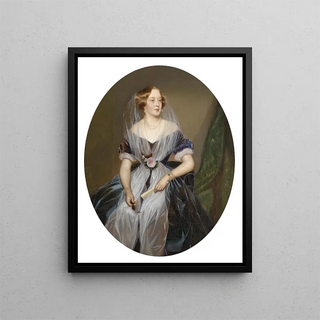Art print | Portrait of a noble lady - Ferdinand Georg Waldmüller


View from behind

Frame (optional)
In the vast panorama of art history, some works stand out for their ability to capture the very essence of humanity. The "Portrait of a Noble Lady" by Ferdinand Georg Waldmüller is one such creation that transcends time and space. This painting, created in the 19th century, bears witness to an era when portrait painting reached heights of finesse and psychological depth. Through the gaze of this noble lady, the artist invites us to explore a world where beauty intertwines with the complexity of human emotions. The art print of this iconic piece offers a unique opportunity to delve into Waldmüller's rich and nuanced universe, while adding a touch of sophistication to our environment.
Style and uniqueness of the work
Waldmüller's style is characterized by a realistic approach, where every detail is meticulously rendered, creating an atmosphere that is both intimate and authentic. In the "Portrait of a Noble Lady," mastery of light and shadow reveals a rare psychological depth, allowing the viewer to glimpse the soul of the subject. The delicate colors, carefully chosen, add a vibrant dimension to the canvas, while the elegant posture of the lady evokes both dignity and vulnerability. This portrait does not merely depict an aristocratic figure; it tells a story, that of a woman rooted in her time, yet whose emotions still resonate today. Waldmüller succeeds in infusing a palpable life into his subject, making this work a true masterpiece of art print portraiture.
The artist and his influence
Ferdinand Georg Waldmüller, born in 1793 in Vienna, is an emblematic figure of the Austrian Romantic movement. His artistic career is marked by an incessant quest for truth and authenticity, both in his portraits and landscapes. Influenced by the great masters of the past, he develops a personal style that combines realism and sensitivity. Waldmüller stands out for his ability to capture fleeting moments of everyday life, through impeccable technique and a keen sense of observation. His influence extends to

Matte finish

View from behind

Frame (optional)
In the vast panorama of art history, some works stand out for their ability to capture the very essence of humanity. The "Portrait of a Noble Lady" by Ferdinand Georg Waldmüller is one such creation that transcends time and space. This painting, created in the 19th century, bears witness to an era when portrait painting reached heights of finesse and psychological depth. Through the gaze of this noble lady, the artist invites us to explore a world where beauty intertwines with the complexity of human emotions. The art print of this iconic piece offers a unique opportunity to delve into Waldmüller's rich and nuanced universe, while adding a touch of sophistication to our environment.
Style and uniqueness of the work
Waldmüller's style is characterized by a realistic approach, where every detail is meticulously rendered, creating an atmosphere that is both intimate and authentic. In the "Portrait of a Noble Lady," mastery of light and shadow reveals a rare psychological depth, allowing the viewer to glimpse the soul of the subject. The delicate colors, carefully chosen, add a vibrant dimension to the canvas, while the elegant posture of the lady evokes both dignity and vulnerability. This portrait does not merely depict an aristocratic figure; it tells a story, that of a woman rooted in her time, yet whose emotions still resonate today. Waldmüller succeeds in infusing a palpable life into his subject, making this work a true masterpiece of art print portraiture.
The artist and his influence
Ferdinand Georg Waldmüller, born in 1793 in Vienna, is an emblematic figure of the Austrian Romantic movement. His artistic career is marked by an incessant quest for truth and authenticity, both in his portraits and landscapes. Influenced by the great masters of the past, he develops a personal style that combines realism and sensitivity. Waldmüller stands out for his ability to capture fleeting moments of everyday life, through impeccable technique and a keen sense of observation. His influence extends to






